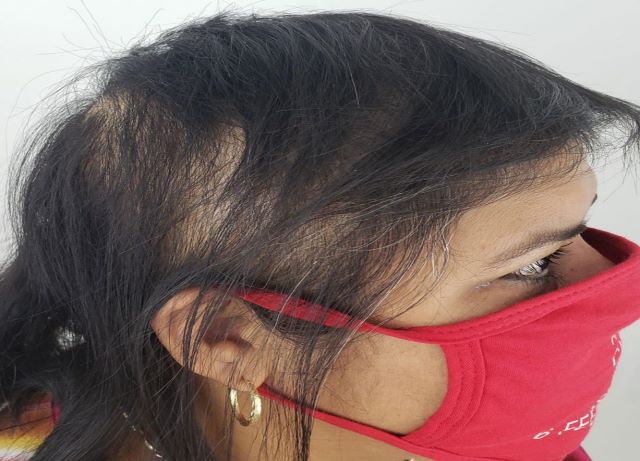Most people associate hair loss, thinning hair, and baldness with men, although up to 49% of Australians with hair loss are female. That is the reason why women’s interest in hair loss treatments has surged recently and micropigmentation is the treatment of choice. This article provides an overview of this process for women and the reasons behind its growing popularity.
What is Scalp Micropigmentation for Women?
Hairline micropigmentation for females is a unique process that involves adding colours to the skin beneath the scalp. The procedure hides bald areas and thinning hair, creating the illusion of thick, natural hair. Practitioners begin the treatment by evaluating the client’s scalp to determine which regions require pigmentation without jeopardising existing hair.
The optimal outcomes for women’s scalp micropigmentation are scalp micro-pigments, female scalp tattoos, and cosmetic pigmentation. The proceduretypically requires two to three sessions to get the desired results, with 7 to 14 days between sessions to enable the skin to recuperate. Although males make up the majority of cosmetic pigmentation clientele, women can also benefit from this technology. Practitioners also have specific techniques for diverse female baldness types.
Why is Micropigmentation Growing in Popularity?
Men and women increasingly use cosmetic scalp pigmentation for hair loss and scar concealing. Most clients opt for micropigmentation since it is similar to getting a tattoo and does not require surgery. Here are five additional reasons why scalp micropigmentation in women is becoming the preferred treatment:
1. Minimal soreness and discomfort
Adding colours to the scalp is an artistic tattooing technique that causes less pain or discomfort than hair transplants and other surgical procedures.
2. Immediate results
Micropigments provide instantaneous aesthetics, allowing the client to leave the initial operation with a flawless hair appearance. With modest adjustments, you can return to regular activities immediately after cosmetic scalp pigmentation. Plus, the result of the final procedure is nearly indistinguishable from natural hair.
3. Low maintenance required
Hair transplants, lotions, and other hair loss therapies are costly to maintain and disruptive to the client’s finances and lifestyle. On the other hand, cosmetic pigmentation provides women with an inexpensive, low-maintenance alternative for thinning hair. The effects persist between four to six years and they may repeat the treatment to restore their appearance.
4. No adverse effects
The sessions of this treatment are separated by around two weeks. If the person follows the advice of an expert practitioner, they may anticipate an infection-free and side-effect-free recovery phase. Moreover, if the patient is concerned about an allergic response, a patch test before administering the therapy can help.
5. Suitable for all skin types
Scalp micropigmentation in women is adjustable and suitable for various skin and hair types and client preferences. The practitioner will strive to match the skin and hair colour of the client to achieve a natural appearance. In addition to hiding scars and other flaws on the scalp, hair tattooing emphasises existing follicles to create the illusion of thick hair.
How Does the Micropigmentation Procedure Work?
Women’s SMP is a cost-effective hair loss treatment involving tattoo-like scalp colouring. The treatment does not include adding hormones or transplanting hair follicles. It matches the client’s hair and skin tone to conceal bald areas. Consult an expert if you have pattern baldness or thinning hair to discover if adding micro-pigments is a possible solution for you.
Each artist has distinct methods when it comes to scalp tattooing. However, the following phases are typically included in the creative process:
• Initial Client Evaluation – The initial client evaluation is necessary for aesthetic scalp pigmentation. The person can do this by visiting their local clinics and meeting the practitioner. Some also accept photographs and videos shared via email or chat for remote assessment. Initial evaluations may also include complimentary telephone consultations.
• Review of Treatment Plan- Once the evaluation is complete; the practitioner will develop a treatment plan tailored to your specific requirements. In addition, they will give direction from the beginning until the end. The client can examine a hairline mockup to visualise how their scalp and hair will appear following the final treatment.
• Appointment and Procedure- If you are happy with the mockups and individualised treatment plan, the practitioner will schedule an appointment for the initial procedure and guide how to arrange it throughout the whole process. The final step includes meticulously applying colours. The majority of patients require at least two sessions to attain optimal results.
• Follow-Up Conversations- Some practitioners give follow-up calls to evaluate whether the client requires additional services and to monitor the outcomes. Additionally, they may contact the practitioner if they want clarification or assistance with any emerging scenario. Scalp micropigmentation on women for cosmetic purposes often does not require intensive upkeep.
Reliable Scalp Micropigmentation in Melbourne
Scalp micropigmentation on women requires professional artists or practitioners that deliver high-quality services and prioritise addressing the client’s demands. Scalp Ink is a renowned clinic for the treatments like SMP. Talk with their specialists in Melbourne about scheduling a consultation. You can call on 0483 909 893 or email at [email protected] if you want to know more about female scalp tattoos.

As the editor of the blog, She curate insightful content that sparks curiosity and fosters learning. With a passion for storytelling and a keen eye for detail, she strive to bring diverse perspectives and engaging narratives to readers, ensuring every piece informs, inspires, and enriches.










